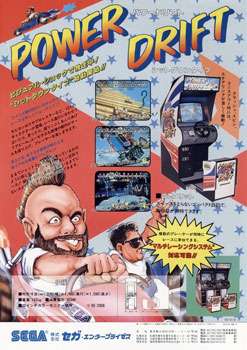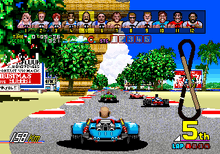Power Drift
Power Drift (パワードリフト, Pawā Dorifuto) is a kart racing game released in arcades by Sega in 1988. Like Sega's earlier racing games Hang-On (1985) and Out Run (1986), Power Drift makes pervasive use of sprite scaling to give a 3D feel. The upgraded hardware of the Sega Y board also allows individual sprites and the background to be rotated–even while being scaled–making the visuals more dynamic.[4]
| Power Drift | |
|---|---|
 Japanese arcade flyer | |
| Developer(s) | Sega AM2 Activision (home computers) Copya Systems (PCE) |
| Publisher(s) |
|
| Director(s) | Yu Suzuki[1] |
| Producer(s) | Yu Suzuki |
| Designer(s) | Yu Suzuki[2] |
| Composer(s) | Hiroshi Kawaguchi Alberto Jose Gonzalez (MSX) |
| Platform(s) | Arcade, Amiga, Amstrad CPC, Atari ST, Commodore 64, Dreamcast, MS-DOS, MSX, PC Engine, Saturn, ZX Spectrum, Nintendo 3DS |
| Release | Arcade
|
| Genre(s) | Kart racing |
| Mode(s) | Single-player |
| Arcade system | Sega Y Board[4] |
| Display | Raster 320 x 224 pixels (Horizontal), 24,576[5] out of 2,097,152 colors[4] |
Gameplay

The objective is to finish each race in third place or better in order to advance to the next stage. Players have the option of continuing if they finish the race in fourth place or lower before the game is over. However, the player's score will not increase upon continuing the game.
Courses
The tracks have a roller coaster feel to them, with lots of steep climbs and falls, as well as the ability to "fall" off higher levels. To add to this feeling, the sit-down cabinet was built atop a raised hydraulic platform, and the machine would tilt and shake quite violently. Each circuit, labeled from "A" to "E" has a certain theme to it (for example, circuit A has cities, circuit B has deserts, circuit C has beaches, etc.) in a series of five tracks. There are also four laps for each course. Course A was Springfield Ovalshape, Foofy Hilltop, Snowhill Drive, Octopus Oval and Curry De Parl, Course B was Swingshot City, Phantom Riverbend, Octangular Ovalshape, Charlotte Beach and Highland Spheres, Course C was Bum Beach, Jason Bendyline, Nighthawk City, Zanussi Island and Wasteman Freefall, Course D was Mexico Colours, Oxygen Desert, Jamie Road, Monaco Da Farce and Blow Hairpin, Course E was Aisthorpe Springrose Valley, Patterson Nightcity, Lydia Rightaway, Bungalow Ridgeway and Karen Longway, The two extra stages with Courses A, C and E resemble a jet fighter from After Burner II and Courses B and D resemble a superbike from Super Hang-On.
Music
Each course in the game has a theme song:
| Course | Song |
|---|---|
| Course A | Side Street |
| Course B | Like the Wind |
| Course C | Silent Language |
| Course D | Adjustment Mind |
| Course E | Artistic Traps |
Ports
Power Drift was later ported to the Amstrad CPC, Commodore 64, MSX, Amiga, Atari ST, MS-DOS and ZX Spectrum by Activision and released in 1989. The home ports lack the tilting action seen in the original arcade version. The Spectrum version knocked the long-standing Robocop from the top of the sales charts.[6] A PC Engine version was developed by Copya Systems and published exclusively in Japan by Asmik Ace Entertainment on April 13, 1990.
A 32X port was in development by Sega, but not published.[7] Dempa was working on a Sega CD conversion that also did not reach store shelves.[7]
If players place first on all five tracks (which is indicated by all five gold trophies on the number of wins display behind the course letter), an "Extra Stage" is unlocked, where the assigned car is a vehicle from other Sega games. Courses A, C and E allow players to race with the F-14 Tomcat fighter jet from the After Burner series in the Extra Stage, while courses B and D have an option to race the motorcycle from the Hang-On series. Players also can press the start button while in a race to see a rear view.
Reception
In Japan, Game Machine listed Power Drift on their , 1988 issue as being the second most-successful upright arcade unit of the year.[8]
Legacy
Sega later ported included Power Drift in the Sega Saturn compilation series Sega Ages released February 26, 1998 and in Yu Suzuki Game Works Vol. 1 for the Dreamcast released December 1, 2001.
References
- "株式会社Ys Net".
- "Power Drift , Arcade Video game by SEGA Enterprises (1988)".
- "SEGA AGES/パワードリフト". Sega. Archived from the original on July 10, 2001. Retrieved 2015-05-30.
- "Sega Y Board". System 16.
- "Archived copy". Archived from the original on 2014-09-06. Retrieved 2014-09-16.CS1 maint: archived copy as title (link)
- "Archived copy". Archived from the original on 2016-05-11. Retrieved 2016-05-18.CS1 maint: archived copy as title (link)
- Kuboki, Kei (March 1995). "Special K's Japan Now - Special K's last-minute info". GameFan. Vol. 3 no. 3. DieHard Gamers Club. p. 114.
- "Game Machine's Best Hit Games 25 - アップライト, コックピット型TVゲーム機 (Upright/Cockpit Videos)". Game Machine (in Japanese). No. 340. Amusement Press, Inc. 15 September 1988. p. 21.
External links
- Power Drift at the Killer List of Videogames
- Power Drift at arcade-history
- Power Drift (arcade version) at System16.com
- Power Drift at MobyGames
- Power Drift at SpectrumComputing.co.uk